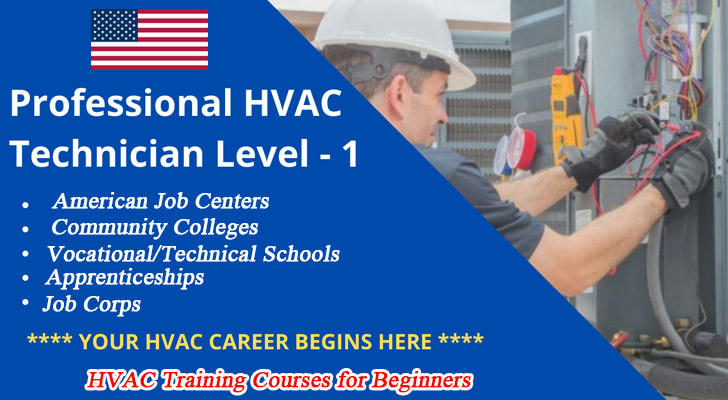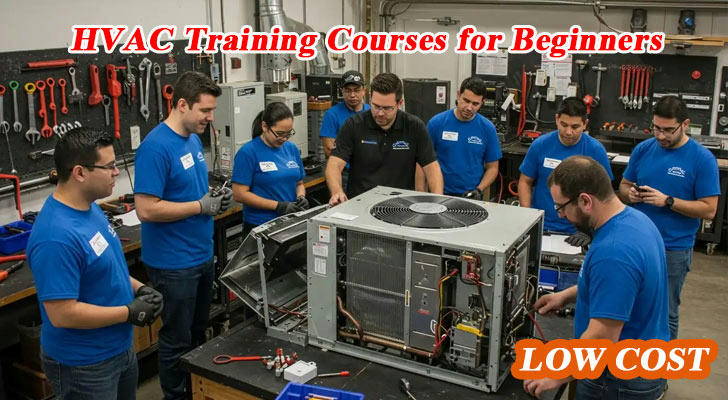📢How to study low-cost HVAC training courses in the United States through public resources?
📢 Becoming an HVAC technician is easier than ever + earn while you learn + tons of resources

In the United States, HVAC (Heating, Ventilation, Air Conditioning, and Refrigeration) technicians are in high demand and can earn good wages. For individuals looking to enter this field at a lower cost, utilizing government-provided resources for training is a smart approach. These resources aim to foster workforce development, enhance employment skills, and make professional training more accessible.
1. Workforce Innovation and Opportunity Act (WIOA)
The Workforce Innovation and Opportunity Act (WIOA) is a primary source of federal funding for workforce development in the U.S. WIOA aims to help job seekers acquire the skills, education, and support services needed for employment.
- How to Utilize: WIOA operates through local American Job Centers (also known as One-Stop Career Centers). Applicants can visit their nearest Job Center to meet with a career advisor and assess their eligibility. If qualified (typically based on income levels, unemployment status, or specific groups like veterans, low-income families, etc.), applicants may gain access to:
- Training Vouchers or Grants: These can cover tuition, book fees, and some related expenses for HVAC certification courses at community colleges or vocational schools.
- Career Guidance and Employment Services: Assistance with selecting suitable courses, resume and interview preparation, and job searching after training completion.
- Duration: less than 12 weeks Occupational Skills certificate or credential
- How to Find:
- Visit the U.S. Department of Labor's CareerOneStop website and input your state to find a list of WIOA-approved training programs in that state. Many HVAC programs are included.
- Contact your local American Job Center directly.
2. Community Colleges and Vocational Technical Schools
Community Colleges and Vocational/Technical Schools across the U.S. are key institutions offering HVAC training programs, and their tuition fees are generally much lower than four-year universities.
- Impact of Government Funding: Many community colleges and vocational schools receive state and federal funding, which helps keep their tuition relatively affordable. Additionally, they often collaborate with local Job Centers, and their HVAC programs typically qualify for funding through initiatives like WIOA.
- Course Types: They usually offer:
- Certificate Programs: Typically 6-12 months, focusing on quickly acquiring core industry skills. Costs can range from approximately $1,200 - $15,000.
- Associate Degree Programs: Around 2 years, offering more comprehensive content suitable for those seeking deeper theoretical knowledge or future management roles. Costs typically range from $15,000 - $35,000.
- How to Reduce Costs:
- Federal Student Aid (FAFSA): Fill out the Federal Application for Student Aid (FAFSA) to apply for a Federal Pell Grant and low-interest student loans.
- State Government Grants and Scholarships: State governments and in-state educational institutions often provide grants and scholarships specifically for vocational training.
- Institutional Scholarships: Many community colleges and vocational schools offer scholarships based on financial need or academic merit.
- On-Campus Employment: Apply for on-campus jobs, such as Work-Study programs.
3. Apprenticeships
HVAC apprenticeships offer a "earn-while-you-learn" training model, combining on-the-job training under experienced technicians with classroom instruction.
- Government-Registered Apprenticeships: The U.S. Department of Labor supports Registered Apprenticeship Programs. These programs are government-certified, ensuring high-quality training standards.
- Cost-Effectiveness: A major advantage of apprenticeships is that participants earn wages while learning,Average salary is mostly between $15.00 and $25.00,and training costs are typically very low, often covered by the employer. The total cost for an apprenticeship might range from $500 - $2,000.
- Duration: HVAC apprenticeships usually last 3-5 years.
- How to Find:
- Visit the Apprenticeship.gov website, the official platform of the U.S. Department of Labor, to search for registered apprenticeship opportunities.
- Contact local HVAC industry associations, trade unions (such as UA Plumbers, Pipefitters, and HVACR Technicians), or large HVAC companies, as they often operate or participate in apprenticeship programs.
- Local American Job Centers can also provide relevant information and referrals.
Here's an example table illustrating HVAC apprenticeship salary progression. Please note that these figures are estimates, and actual salaries can vary significantly based on region, employer, apprenticeship program (union or non-union), individual performance, and local cost of living.
| Apprenticeship Stage | Cumulative Duration | Salary Range (% of Skilled Technician Hourly Wage) | Estimated Hourly Wage Range | Estimated Annual Salary Range |
|---|---|---|---|---|
| Year 1 / Stage 1 | 0 - 12 months | 50% - 60% | $15.00 - $20.00 | $31,200 - $41,600 |
| Year 2 / Stage 2 | 13 - 24 months | 60% - 70% | $18.00 - $25.00 | $37,440 - $52,000 |
| Year 3 / Stage 3 | 25 - 36 months | 70% - 80% | $21.00 - $30.00 | $43,680 - $62,400 |
| Year 4 / Stage 4 | 37 - 48 months | 80% - 90% | $24.00 - $35.00 | $49,920 - $72,800 |
| Year 5 / Stage 5 | 49 - 60 months | 90% - 95%+ | $27.00 - $40.00 | $56,160 - $83,200 |
| Skilled Technician (Post-Apprenticeship) | 60+ months | 100% | $30.00 - $50.00+ | $62,400 - $104,000+ |
4. Job Corps
Job Corps is a federal program operated by the U.S. Department of Labor, providing housing, vocational training, education, and employment support for low-income youth aged 16 to 24.
- Target Audience: If an individual meets the age and income requirements, Job Corps can be an excellent option.
- HVAC Training: Many Job Corps centers offer HVAC pre-apprentice training programs, preparing students for entry into registered apprenticeships or direct employment.
- Benefits: In addition to training and housing, Job Corps provides living allowances, health care, and job placement services.
- How to Apply: Visit the official Job Corps website or contact a local admissions office for more information and the application process.
5. Other Potential Resources
- Veteran Benefits: If an individual is a veteran, benefits such as the GI Bill can be used to cover the majority of HVAC training tuition and living expenses.
- State and Local Workforce Development Agencies: Each state and many counties/cities have their own workforce or economic development agencies, which may offer additional training grants or resources.
- Non-Profit Organizations and Industry Association Scholarships: Some HVAC-related non-profit organizations or industry associations (like ASHRAE, ACCA, etc.) may offer scholarships or grants.
Conclusion
Learning HVAC training courses at a low cost through government resources in the U.S. is entirely feasible. The key is to proactively contact local American Job Centers, explore federal funding programs like WIOA, and investigate various avenues such as community colleges, apprenticeships, and Job Corps. These resources can significantly help applicants reduce their financial burden for education, while also providing valuable career guidance and employment support, paving the way for a successful entry into the HVAC industry.
All information is collected from publicly available resources such as Apprenticeship.gov and local union training programs.

